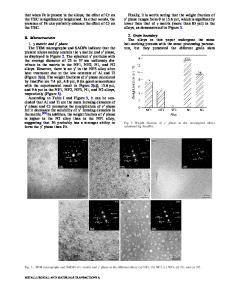Thermal expansion behavior of bulk Bi-based (2223) superconductors
- PDF / 270,070 Bytes
- 8 Pages / 612 x 792 pts (letter) Page_size
- 10 Downloads / 364 Views
MATERIALS RESEARCH
Welcome
Comments
Help
Thermal expansion behavior of bulk Bi-based (2223) superconductors A. Bellosi, G. Celotti, E. Landi, and A. Tampieri IRTEC-CNR, Research Institute for Ceramics Technology, via Granarolo 64, 48018 Faenza, Italy (Received 7 February 1995; accepted 29 February 1996)
The thermal expansion coefficient of Bi-based 2223 and 2212 ceramics has been measured using dilatometric apparatus. Different typologies of bulk superconducting samples have been tested, in particular (2223) phase fully dense hot-pressed samples both parallel and perpendicular to the direction of applied pressure, pressureless sintered samples, and finally hot-pressed (2212) phase specimen, in order to gather information on the contribution of secondary phase to thermal expansion behavior. From the observed a (thermal expansion coefficient) values, accounting for the sample orientation degree, it was possible to distinguish the contributions along the basic crystallographic directions and to determine the following for (2223) phase: aa 12.2 3 1026 ±C21 , and ac 20.8 3 1026 ±C21 for temperatures 200 –600 ±C. Theoretical a values were then calculated for the different samples and successfully compared with the measured ones. As regards (2212) phase, thermal expansion coefficient was evaluated for the oriented sample, and a value for random one extrapolated; the results are very similar to that of (2223), but lower with respect to previously reported data in air atmosphere.
I. INTRODUCTION
II. EXPERIMENTAL PROCEDURE
The importance of the attainment of dense, single phase ceramics of Bi-based high Tc superconductor became more and more relevant as the research emphasis shifted from a mere critical temperature increase toward materials engineering and processing. The influence of density, grain size and texture, large inclusions or voids, secondary phases in the bulk or at grain boundaries, and region of off-stoichiometry is determinant on the reproducibility of the superconducting properties, as well as on the reliability of mechanical, thermal, and more in general of technological properties. Indeed for the preparation of specific devices, which include metal-sheated tapes of the superconducting oxide or composites with metal-ceramic junctions, a detailed knowledge of the physical properties of the single component is required, one important parameter being the anisotropic thermal expansion of superconducting ceramics. Up to now dilatometric measures to evaluate the thermal expansion behavior have been considered unreliable and inadequate to detect the anisotropic differences of such materials due essentially to the low density reached in the preparation of bulk samples.1–3 In the present paper hot-pressing was used to prepare highly dense superconducting material with textured microstructure, perfectly suitable for accurate dilatometric measurements, and to determine a thermal expansion coefficient that accounts for the material texture degree.
A. Powders and materials
J. Mater. Res., Vol. 11, No. 7, Ju
Data Loading...











